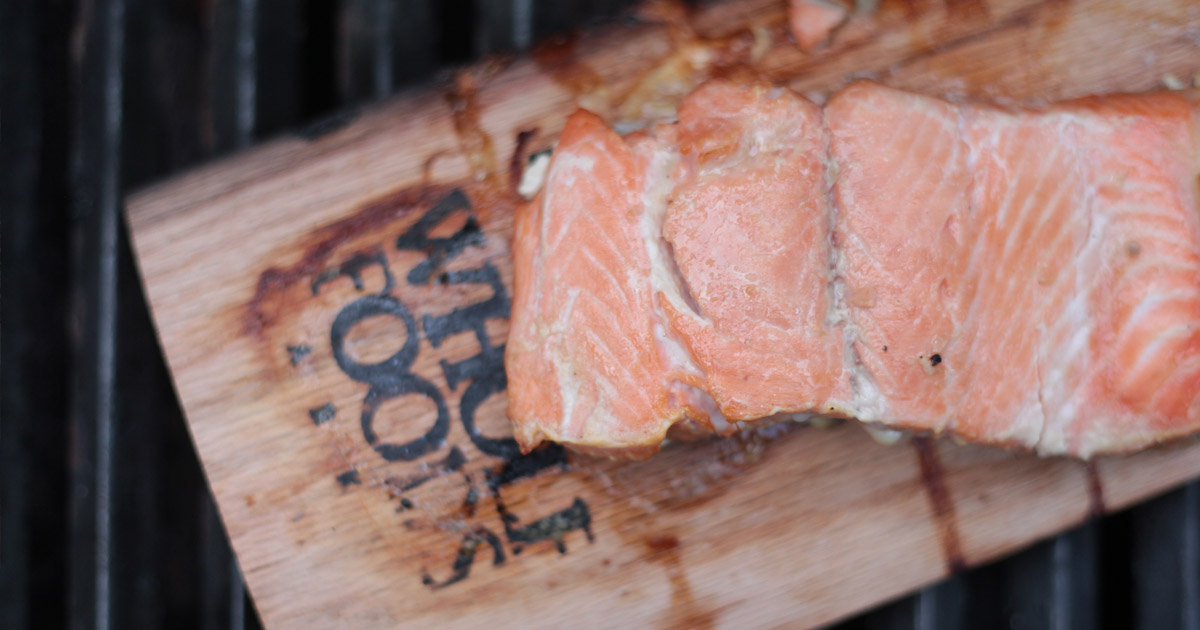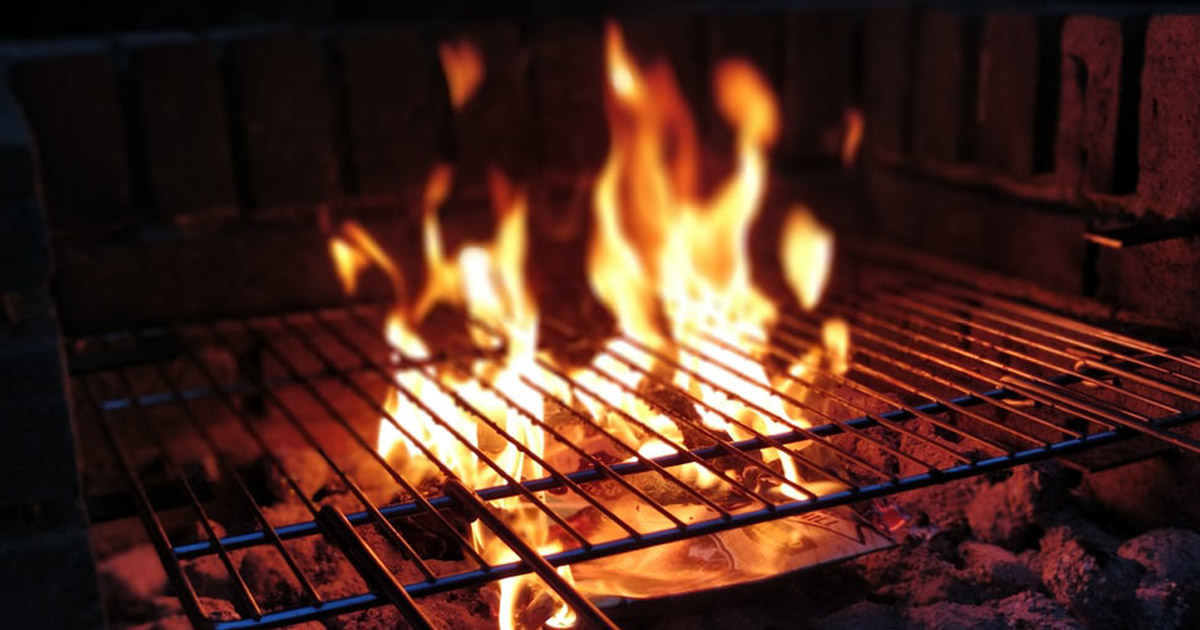In this post, we're delving into the topic of "grilling planks." We'll explain what grilling planks are, and which wood is suitable for salmon and meat. Additionally, you'll learn how to grill fish and meat using a grilling plank for the best results. We'll also cover cleaning and reuse of grilling planks.
What are Grilling Planks and Where Do They Come From?
The history of grilling planks dates back to the Native Americans. Even back then, captured fish were grilled on cedar wood. This makes sense because meats like poultry, beef fillet, seafood, and fish such as salmon and trout can tolerate only a little heat. Grilling planks help gently cook meat and fish, preventing them from burning. Another advantage of grilling with planks is the distinct flavor that the cooked fish or meat acquires. The wood of the grilling plank releases various flavors when heated, which are absorbed by the meat and fish. This results in a unique and special taste that can only be achieved through the use of grilling planks. The type of wood used for the grilling plank plays a significant role (more on this later).
The technique of plank grilling or "plank grilling" is becoming increasingly popular in the USA and Canada. However, in Europe, grilling with planks is relatively unknown. Therefore, among barbecue enthusiasts, it's considered a true hidden gem. If you haven't experienced grilling with planks yet, make sure to try it out at the next opportunity – you'll thank us later!
To sum it up in two sentences: Plank grilling refers to preparing fish and meat on a wooden board. This is quite popular in the USA and Canada, but in Europe, it's more of an insider's tip.
Grilling Planks: Which Wood for Fish and Meat?
As we mentioned earlier, grilling planks are suitable for fish and meat that can only handle low heat. This includes poultry, beef fillet, game, seafood, and fish – even pork can be easily cooked. For the best flavor, our grill expert Patrick Ryan, who has produced many shows about grilling and BBQ for Kabel 1, recommends using different grilling planks.
Which Grilling Planks are Suitable for Salmon?
When grilling salmon or fish in general, as well as seafood, Patrick Ryan recommends using cedar wood. The so-called Cedar Grilling Planks impart a distinct, slightly sweet flavor to the salmon.
Here's how to perfectly grill salmon with cedar plank: Place the salmon on the grill at around 150°C (300°F) for about 25 minutes (using the cedar grilling plank). This cooking time keeps the fish slightly undercooked and perfectly flavorful. If you want to be sure, pay attention to the protein that will start to emerge after a while. Once protein begins to appear around the edges of the salmon but not on the fish itself, the salmon is done.
ℹ Pro Tip: If possible, do not remove the skin of the salmon when grilling on the cedar plank. Grilling skinless salmon fillets can be quite challenging, and there's a risk of the salmon falling apart quickly.
Which Grilling Planks are Suitable for Poultry and Pork?
If you want to grill a delicious piece of pork or poultry on grilling planks, the best choice is maple wood. The Maple Grilling Planks, made from the wood of the maple tree, impart a particularly sweet and wonderfully balanced, lightly smoky flavor to the meat. Using maple wood grilling planks ensures that the pork or poultry has no direct contact with the flames, resulting in particularly tender and juicy grilled meat.
Here's how to perfectly grill a piece of pork with maple wood grilling planks: Before placing the pork on the grilling plank, trim away any tendons and excess fat. Put the meat on the grilling plank and grill it at around 180°C (350°F) for about 40 minutes. Using a thermometer is recommended to check the core temperature of the pork. This technique is also used by Patrick Ryan, who typically relies solely on the temperature inside the meat, rather than adhering to recommended grilling times. When the core temperature reaches between 58°C and 60°C, the pork is ready to be taken off the grill. Allow the meat to rest for a few minutes after cooking.
ℹ Pro Tip: The Maple Grilling Planks are also excellent for preparing any piece of meat that you want to cook in a bacon wrap.
Which Grilling Planks are Suitable for Beef and Game?
For a juicy piece of beef steak – as well as game meat – we recommend using Hickory Grilling Planks. Hickory wood imparts a particularly distinct smoky flavor to the meat and is a classic choice for Southern-style BBQ. Alternatively, you can also use cherry wood grilling planks.
Before placing the steak on the grilling plank, sear it on both sides for about a minute each. Then, place the meat on the hickory wood grilling plank (or cherry wood) and grill it at around 180°C (350°F). Cook the meat until the desired core temperature is reached. Using a thermometer is recommended here as well. After removing the meat from the grilling plank, let it rest in the open air for about 10 minutes.
ℹ Pro Tip: If you prefer your beef steak to be "medium," remove it from the grilling plank when the core temperature is around 57°C (135°F). For "medium-rare," take the steak off the grill when the core temperature reaches about 52°C (125°F). If you like your steak "rare," still slightly bloody, remove it from the grill at 49°C (120°F).
Grilling Planks: Soaking, Cleaning, Reusing
The correct usage of grilling planks is particularly important. For this reason, the grilling planks made by American Heritage in the USA come with instructions that are conveniently embossed directly onto the wood.
- The grilling plank should be soaked in water for 1-2 hours
- Place the pre-seasoned meat on the wet grilling plank
- Position the grilling plank on a preheated grill
- Ensure that the grill is closed during cooking
- Consider the different cooking times for meat and fish
- For safety, have a spray bottle of water near the grill to quickly react if the grilling plank starts to burn
ℹ Pro Tip: If you can't find a suitable container for soaking the grilling plank, you can easily use a baking sheet from your oven.
Often, we're asked if grilling planks can be reused. The answer is: Yes! You can reuse grilling planks multiple times as long as you've thoroughly cleaned them after grilling. Please also ensure that the grilling plank is not burned or overly charred. If that's the case, the smoky flavor that the fish and meat acquire from the grilling plank might not be as intense. In that case, it makes sense to use a new grilling plank.
The proper care and correct cleaning of the grilling planks is essential if you intend to use them multiple times. Make sure the grilling plank is completely cooled down before starting the cleaning process. Use a brush and hot water to completely remove fish or meat residue from the grilling plank. Let the cleaned grilling plank dry completely in a well-ventilated area at room temperature. Do not place the cleaned and still damp grilling plank on a heater or in the sun, as this could cause the wood to crack.
On the internet, dish soap is often recommended for cleaning grilling planks. However, we can only discourage that practice, as the wood can absorb some of the soap, leading to taste alterations. Please do not use a dishwasher for cleaning grilling planks.
Important Notes about Grilling Planks – What to Watch For
To ensure food safety, American Heritage exclusively sells wood and grilling planks that are made from pure and ecological woods. For this reason, you should only buy products that are clearly labeled as "grilling planks". The wood must be completely untreated – so it's not advisable to head to the nearest hardware store and get a bunch of boards for your home grill.
If you want to use multiple grilling planks while grilling, make sure to place them with a gap of at least 2 cm (0.8 inches) between them; otherwise, the smoke won't have a chance to penetrate. As mentioned earlier, the grill should always be preheated before placing the grilling plank and the food on it.
Although you might not think so by looking at it, the grilling plank becomes very, very hot on the grill. Therefore, please do not touch the wood with your hands (unless you're wearing appropriate gloves). If possible, always use grilling tongs.
We wish you bon appétit!




